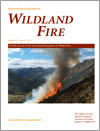International Journal of Wildland Fire
Volume 20
Number 4 2011
Wildfire growth in the boreal Alaskan interior is shown to be primarily a response to post-ignition meteorological conditions rather than antecedent conditions. Prolonged dry periods post ignition associated with large-scale blocking enabled fire growth for large fires, whereas the onset of wetting precipitation inhibited fire growth for small fires.
This paper describes a modified burned area mapping algorithm based on standard MODIS products aimed at improving burned area estimates in Alaska and other high northern latitude regions. The existing MODIS-based products underestimate burned area because of difficulties in mapping large late-season burns imposed by high solar zenith angles, smoke plumes, cloud and snow cover.
We provide an objective weather-based definition of ‘spread events’, making it possible to assess the probability of having a spread event on any particular day. We demonstrate the benefit of incorporating this ‘spread event’ day concept into a fire-growth model based on the Canadian FBP System.
This paper presents a statistical model for producing maps of California Federal and State lands showing expected numbers, locations and suppression costs of fires larger than 200 ha for the upcoming summer months using vegetation, topography and hydroclimatic data as predictors.
Our study determined the accuracy of a statistical model derived using satellite data and field-based burn severity data from 10 wildland fires in Canada. The results show that an overall model is effective at mapping and characterising the effects of fire across multiple landscapes and through time in our study area.
The area of an African savanna burnt per annum depended on the amount of wet-season rainfall. Neither occasional winter rainfall nor attrition of fuel by large herbivores had an influence, but rainfall of the preceding wet season had an influence during years with no winter rainfall.
Fire return period varied across an African savanna from no occurrence to a fire every 1.76 years, on account of variation in mean annual rainfall (hence fuel load), differences among vegetation types in fuel load and flammability, and the distribution of herbivores (because of their effects on fuel load).
The effect of climate change on fire weather in eastern Australia is explored by using global climate models to calculate the forest fire danger index for four large regions along a latitudinal gradient corresponding to rainfall seasonality. There is expected to be an increase in and earlier start to fire weather in the cool temperate south, but a decrease or little change from 20th century levels in the tropical and subtropical north.
Simulations using a fire regime and carbon dynamics model indicate that projected warmer and drier climates in south-eastern Australia are likely to increase fire activity, reduce carbon stores and increase carbon emissions. Simulated fire management practices have the potential to partially offset the adverse effects of climate on fire activity but not on carbon dynamics.
Tropical peatland fires require particular attention, because they make a substantial contribution to the global burden of greenhouse gases and therefore to climate change. This study emphasises the effect of repeated fires on land-cover change on peatland in Indonesia. Comprehensive analysis of fire regimes and land-cover dynamics over the period 1973–2005, derived from a series of high-resolution satellite images, provides essential data and a firm base for future detailed study of climate change and vegetation rehabilitation in the tropical peatland ecosystem.
Litter accumulations at tree bases in long-unburned, fire-adapted ponderosa pine stands are prone to prolonged combustion and excessive consumption. In order to minimise tree injury during the reintroduction of prescribed fire, this laboratory-based smouldering combustion experiment was performed to identify and quantify the primary determinants of duff mound consumption.
Managers in the Great Basin are concerned with promoting mountain big sagebrush and deterring cheatgrass invasion following fire. We examine the interacting influences of pre-fire tree canopy cover, perennial species cover, distance from potential seed source, and site environment on post-fire cover of Bromus tectorum and Artemisia tridentata.
We analysed the breeding success of a reputed generalist avian species, the great tit, in woodlands with different post-fire ages. Although the incubation fate improved gradually as woods recovered from fire, we found that the great tit regained its full productivity only in the oldest forests.
This paper explores how social diversity of residents living in wildfire-prone peri-urban interface areas influences local environmental knowledge and wildfire preparedness. We present a practical framework to complement existing risk education mechanisms with engagement techniques that facilitate improved community-wide learning about wildfire and wildfire preparedness.




